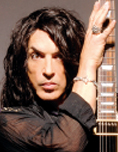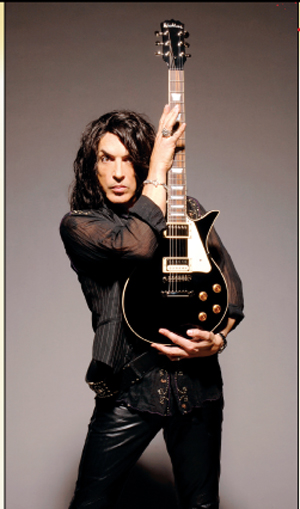Paul Stanley: Some Kind of Minister


Originally printed in Guitar World Magazine, February 2008
With his flashy new Washburn Preacher ax, Kiss axman Paul Stanley delivers a modern gospel on traditional guitar design.
Kiss’ guitar player is a man who knows what he wants out of life, and that includes guitars. Over the years, he’s had endorsement deals with Gibson, Ibanez and Samick, but he feels that he’s finally realized his dream guitar with the PS9200 Preacher, his newest signature model from Washburn.
“It’s called the Preacher because I see it as a guitar that has real blues roots,” Stanley explains. “You can preach the gospel of rock and roll and blues on this guitar. You can really testify. This guitar preaches.”
It’s a traditional design, very much in the spirit of the Les Paul, but with a few stylistic flourishes that could only have come from the mind of the man who helped originate the world’s reigning cartoon superhero rock band, Kiss. The lower body bout very closely resembles the Les Paul, but the upper bout is more abbreviated and curvilinear.
“I wanted to make a guitar that looks like it could have come out in the Fifties, only you just haven’t seen it until now,” Stanley explains. “I wanted a guitar that adheres to all the hallmarks of a classic guitar.”
As Stanley sees it, any great luthier can make a great guitar; it’s the aesthetics that require someone with something special. “And that’s where I come in. Too many new guitars are either poorly designed or just goofy looking. They’re different for the sake of being different, but they don’t stand up in terms of design.”
Get The Pick Newsletter
All the latest guitar news, interviews, lessons, reviews, deals and more, direct to your inbox!
A lover of classic guitars, Stanley has owned “everything from a ’58 V to a primo Les Paul sunburst. All my heroes, Jimmy Page, Eric Clapton, Mike Bloomfield, they all played a Les Paul at some point in time. It’s one of the two most identifiable guitars in the world. But I also believe that just because something is traditional doesn’t mean it’s perfect. Tradition can be improved upon.”
A case in point is the cutaway on the Preacher, which is larger and more dramatic than a Les Paul cutaway. This gives the guitar an eye-catching, catching, curved “horn,” but also enhances playability. “Neck access is much better,” Stanley says. “We took down the back of the heel significantly and angled it so that it fits your palm. You can really wrap your hand around and go as far up on the neck as you want to go. So that’s one improvement upon the tried and true. I call it ‘history with an attitude.’ ”
History is certainly evident in the headstock. Its inlay design is influenced by the early 20th century Art Deco aesthetic. “I like traditional headstocks with three tuners on each side,” Stanley explains. “I don’t like asymmetrical, newfangled looking headstocks. I want something that a young kid can feel comfortable playing; but also an old traditional blues player can pick up this guitar and love it.”
The top-of-the-line Preacher models are equipped with two Seymour Duncan Pearly Gates humbucking pickups. These are based on the pickups in one of the most famous ’59 Les Pauls in all of rock: the sunburst that belongs to ZZ Top’s Billy Gibbons. This pickup choice also reflects Stanley’s preference for traditional values when it comes to guitar gear.
“For me,” Stanley says, “a great pickup means you can hear each string when you strum a chord. I’ve never liked pickups that just put out this blaring, white noise distortion. All the guitar players I love, when they hit a chord, you heard each string. So I prefer either a real vintage pickup or one that’s just a little souped-up. But when you get into superdistortion, super-duper-distortion and superunbelievable- distortion pickups, I’m not interested. They’re not musical pickups. They serve a certain kind of music well, but they don’t suit what I do or what the people I listened to growing up did.
“When I used to go to the Fillmore East as a kid, or go to other concerts, the guitar players had just a guitar and an amplifier. They didn’t need a pedal board that looked like it could make cappuccino and launch missiles. If you couldn’t get the sound you wanted, then you didn’t have the right guitar or amp. Sure there were some pedals, but mostly it was about you, your guitar and your amp. I still gravitate toward that. If you listen to Clapton with the Bluesbreakers, if you listen to Mike Bloomfield with Paul Butterfield, that’s what it was about: a Les Paul into an amp.”
Stanley made extensive use of his Preacher guitars on his recent solo album, Live to Win (New Door Records) and subsequent solo tours in support of the disc. “I’ve never played a better guitar,” he states. “Ever. And I’ve had guitars that are now going for half a million to a million bucks. A lot of times I play my Preacher guitars through Randall amps. They have a lot of the qualities as boutique amps that are astronomically priced, way beyond most people’s range. It’s no secret that most great amps are based on Marshalls. But, again, I think there’s always room to improve on the cornerstones and mainstays of any genre of music.”
The Preacher is just one in a full line of Paul Stanley signature model Washburns, both electric and acoustic. For his work with Kiss he uses a radically different guitar, the latest iteration of which is the PS800. This is a full-on, pointy metal guitar. “The body shape is somewhere between an Explorer and a Firebird,” Stanley says. “It has a little longer lower bout. Arguably it’s a guitar with more rock and roll edge to it, which is great for Kiss.”
One interesting feature is the guitar’s trapeze-style tailpiece, the instrument’s sole vestige of traditional styling. “It’s more cosmetic than anything else,” Stanley admits. “It’s actually a stop tailpiece, but I always loved the trapeze tailpieces on big band guitars or, on the Les Paul SG Customs, the plate over the vibrato mechanism. I just thought it gave the guitar something that validated it as a real instrument. So on that guitar of mine, I wanted to at least replicate a tailpiece, even it if wasn’t functional.”
Stanley has plans for expanding his signature line even further. In true Kiss fashion, his ambition seems endless. “I want to develop a line so that there’s a new version of every classic guitar. What I’m also trying to do is make sure that the beginner can have a good guitar and the person who’s professional can have a great guitar without paying an excessive price. Back in the day, my first SG cost me 120 bucks. My second guitar, which was a Les Paul TV model, cost me 200 bucks. Granted the cost of living has increased since then and everything costs more. But you can turn out a really competitive guitar, and in some cases a better guitar than the competition, for less money. So I want to make sure there’s a cool-looking guitar for the person who wants a certain amount of attitude and aggression in an instrument. And there will also be guitars for the more traditional player. And that’s where the Preacher comes in.”
“I use a spark plug to play slide. It's a trick Lowell George showed me. It gets incredible sustain – metal on metal”: In the face of sexist skepticism, Fanny's June Millington carved a unique six-string path, and inspired countless players in the process
“There’d been three-minute solos, which were just ridiculous – and knackering to play live!” Stoner-doom merchants Sergeant Thunderhoof may have toned down the self-indulgence, but their 10-minute epics still get medieval on your eardrums

![A black-and-white action shot of Sergeant Thunderhoof perform live: [from left] Mark Sayer, Dan Flitcroft, Jim Camp and Josh Gallop](https://cdn.mos.cms.futurecdn.net/am3UhJbsxAE239XRRZ8zC8.jpg)







